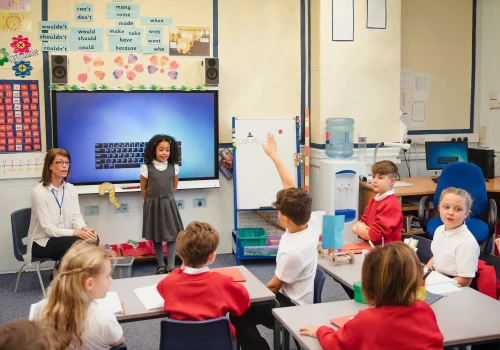Learning how to work alongside automated technologies
Imagine a startup where there are 2.5 robots for each human employee. In this office, humans do the creative work, while the robots, which they affectionately call ‘pups’, do the general, predictable work that an office needs doing, like sorting mail and running things between desks.
This isn’t a scene out of The Jetsons; it’s an actual office in Silicon Valley. It’s called Fetch Robotics, and as a robotics company that seeks to bring robots into the workplace to work seamlessly alongside humans. They aren’t trying to replace humans, CEO Melonee Wise once explained: “No one has ever lost a job because of our robots. … [but] an estimated 600,000 jobs in the United States are going unfilled”, and that is the gap she hopes their robots can fill, at least partially.
In fact, it is becoming increasingly likely that more and more workplaces will adopt automation of some kind. McKinsey Global estimates that 49% of things people get paid to do can be automated using current technologies. Less than 5% of entire jobs could be fully automated, they say, but nearly 60% of all jobs could be at least 30% automated or more. PricewaterhouseCoopers went further, back in 2017, saying that nearly 40% of US jobs were at “high risk” for automation by the 2030s.
What can we do about it? We know from past resistances to technological advancements that we can’t put the genie back in the bottle. So it seems we have two choices: fight and get left behind, or learn to work with automated technologies.
The work most likely to be automated
Automation and robotics are being applied to work humans aren’t physically capable of doing as well as routine tasks like data entry. AT&T, for example, taught technicians to fly drones around cell phone towers. A drone takes close-up, HD video of a tower and sends it to the technician on the ground, who scans the footage for signs of damage to the tower. Where it used to take technicians an hour to climb up a tower and do a detailed inspection, it now takes them minutes – and they stay safely on the ground.
That is how experts see automation and robots fitting into everyone’s work: they will do the dangerous, physically taxing, or monotonous things in a job, while the humans continue to use their expertise to problem solve.
Human skills that can’t be replicated
We can see, then, that the automation tools and robots in the workplace are like Roombas. Yes, a Roomba can vacuum a floor, but there’s still plenty of housework left to do, and it won’t realize that a room needs a deep clean. It can only take care of the monotonous task of sweeping a floor.
In the same way, humans have many abilities that robots and intelligent machines can’t replicate, such as creative problem-solving. The AT&T drones can take a hi-def video of a tower, but they can’t decide how to fix damage or weaknesses. Computers can crunch numbers, but they can’t make conclusions from the vast sets of data. Only humans can look at information and decide what to do with it.
Humans also benefit from diverse backgrounds, points of view, and experiences, which we can bring to new environments and new challenges. Machines can only output based on what we humans input into them. What gets put in is what comes out. Humans, however, can make great cognitive leaps and see exciting and valuable connections between seemingly unrelated areas.
Finally, we have something robots will never have -empathy and human interaction. Think of how many times when laughing with clients or colleagues made your work easier and more enjoyable. Similarly, patients with medical care staff who have a good bedside manner – making them feel listened to and cared about – have better health outcomes. Robots and automation technologies can’t tell stories. They can’t give hugs with the warmth of human touch.
Any part of any job that requires human connection simply can’t be replicated by robots.
Learning to work together
Robots, computers, and other intelligent machines can only do so much, but that is still quite a lot. It will quickly prove both profitable and efficient for offices to have robots and other automated technology. Some jobs will be lost as a result, but others, like “automation ethicist” and “interactive chatbot designer” are going to become staples of the future workplace. People will be needed to program, install, and repair corporate robots.
Even more than these new jobs, however, automation will open up opportunities in existing jobs. As pointed out above, 60% of jobs will be at least one-third automated. That leaves two-thirds of the job left for a human who can work with automation technology. Dennis Yang of Udemy wrote in VentureBeat: “In our 21st-century workplace, the ability (and eagerness) to learn new things will elevate driven professionals above the rest. Those who’ve kept their hard skills current through continuous learning and who keep working on their soft skills will do the jobs that robots can’t.”
Coming to this new world with motivation and enthusiasm to learn and continue to develop human skills alongside new tech skills will mean survival for many of us. Indeed, some argue that technology will change so often, we may need to rely on micro-credentials or lifelong studying to keep up. Things like ongoing online education might become the norm as workers in all walks of life have to continue to update their knowledge bases every few years.
Conclusion
Change can be scary for humans, and we have a long history of being resistant to new technologies. Plato famously argued that writing things down would cause us to become forgetful and never truly understand anything. But just as with every other technological advance before, we have reason to be optimistic about incorporating automation and robotics into everyday workplaces. There will be new jobs, and current jobs will become more efficient. As long as we approach the challenges with an eagerness to continue training and learning, we will be okay. Robots will assist us, not replace us.
In fact, at Fetch Robotics they have found one more use for their robots. If an employee types “Robot, I’m hungry” into Slack, a robot with a box of cookies will come to their desk to give them a pick-me-up. If the future of work includes cookie delivery robots, sign me up.





